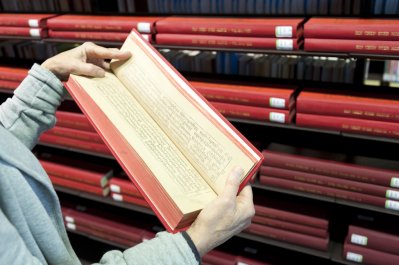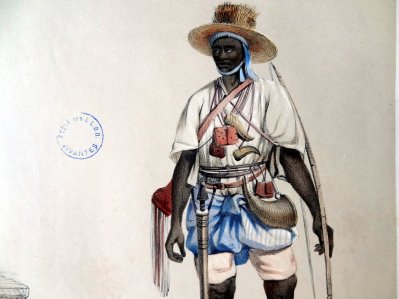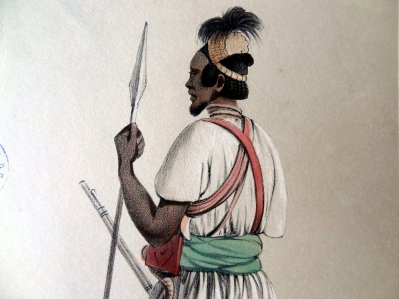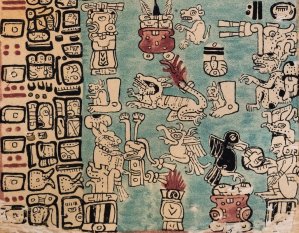Collections
The BULAC's collections give access to a wide range of resources for each geographical area : Africa ; Middle East, Maghreb and Central Asia ; Balkans, Central and Eastern Europe ; Asia ; America and Greenland ; Pacific Oceania.

Le fonds tibétain en libre accès, rez-de-jardin (Grégoire Maisonneuve / BULAC).
General overview
The BULAC's collections give access to 2100 subscriptions to paper journals and 1.5 million documents some of which are accessible for the first time. There are documents from 180 countries in nearly 350 languages - with around 200 languages represented to a significant extent - and in over 80 different scripts. With 6000 m² on three floors and 7000 linear metres of bookshelves, our reading rooms provide you with free access to 10% of all the BULAC's collections. The documents available in free access are classified according to 6 geographical areas along with a "Documentation générale" (general documents) section with documents classified according to 10 disciplinary fields corresponding to different fields of knowledge.
- Over 7000 online journals which are accessible using library workstations or via readers' portable computers.
- Numerous digital periodicals and audiovisual documents.
The BULAC's "Reserve" collection has a wealth of 70,000 rare and precious print documents and over 4000 manuscripts. These notable include:
- About two thousand volumes in Arab and a large number of fragments,
- 197 volumes in Turkish,
- 133 volumes in Persian,
- 55 volumes in Hebrew,
- Around 50 volumes in different Indian languages,
- Other sets of volumes in Pali, Sanskrit, Cham, Khmer, Burmese and various Indo-Chinese languages,
- Other collections in languages like Russian, Armenian, Chinese, Japanese, Malay, Lolo, etc.
- Archives and collections of correspondence.
The collections according to geographical sector
Africa
The African sector covers collections in languages form the South of the Sahara to South Africa. The Ethiopian (4000 books including 1300 in vernacular languages) and Malagasy (4000 books with around 1000 in the Malagasy language) collections are particularly notable. Our African sector has 68,000 books and 400 journals and brings together three collections from:
- the Bibliothèque Interuniversitaire des Langues Orientales (BIULO) [French Inter-University Library of Oriental Languages];
- the library of the Centre d’études africaines (CEAF) [Centre of African Studies Library], at the École des hautes Études en Sciences Sociales (EHESS) [School for Advanced Studies in the Social Sciences];
- the library of the Sociétés en Développement : Études Transdisciplinaires (SEDET) [Developing Societies : Trans-disciplinary Studies], laboratory at université Paris Diderot.
This is one of the priority development areas within the library. Specific areas covered are : Africa, Ethiopian, Hausa, Malagasy, Manding, Fula, Swahili, Wolof, Yorùbá.

Détail de l'ouvrage Voyage dans l'Afrique occidentale. Source de l'illustration.

Détail de l'ouvrage Voyage dans l'Afrique occidentale. Source de l'illustration.
Middle East, Maghreb, Central Asia
The oldest part of the library, this sector contains documents on North Africa, Arab and Berber, the Middle-East and the Iranian and Turkish worlds with all their diversity. As well as a unique collection of books in the different languages of these areas of the world, the library also possesses a rich collection on travel to these areas, geography, history, religion, diplomatic relations and economics. The library's Arab section is among the finest collections in Europe while the Turkish collection has become a reference in the field and the Iranian section now has a complete collection.
Specific fields are Arab, Armenian, Berber, Georgian, Hebraic, Iranian, Turkic, Central Asia.
The Balkans, Central and Eastern Europe
The BULAC is a reference library for Slavic studies (the collections of this sector of the library put together make up nearly half of the whole of the library's total holdings). The Russian holdings come from:
- the the bibliothèque interuniversitaire des langues orientales (BIULO) [French Inter-University Library of Oriental Languages],
- the Sorbonne Slavic Studies Centre,
- the Bibliothèque Juridique sur l’Europe Centrale et Orientale [Central and Eastern Europe Legal Library],
- the Centre d’études des mondes russe, caucasien et centre-européen (CECEC) [Centre for Russian, Caucasian and Central European Studies].
Specific areas covered are Albanian, Baltic, Belarusian, Bulgarian, Finno-Ugric, Greek, Hungarian, Polish, Romanian, Romani, Russian, Sorbian, Czech and Slovak, Czech, Ukrainian, Ex-Yugoslavia.
Asia
This vast section of the library has holdings of varying sizes and importance which have mainly been developed since the end of the 19th century but nonetheless contains certain unique collections. The focus of all the holdings is promoting in-depth knowledge of the languages and countries in Asia and the majority of the books are in the original languages. The oldest and most important holdings are the Chinese reference collection which is currently undergoing an important process of expansion (35,000 titles currently) and the internationally-renowned Japanese collection (52,000 titles).
Specific areas covered are Bengali, Burmese, Cambodian, Chinese, Korean, Hindi, Japanese, Laotian, Malay and Indonesian, Mongolian, Oceanian, Urdu, Philippine, Siamese (Thaï), Tamil, Tibetan and Nepalese, Vietnamese.
America and Greenland

Détail de l'ouvrage d'Étienne-Charles Brasseur de Bourbourg, Manuscrit troano : études sur le système graphique et la langue des Mayas. Source de l'illustration.
This sector is divided into two parts : South America and Mesoamerica ; and North American Arctic. It covers fields of study linked to the original civilisations of Latin American countries, the Greater Antilles and the Canadian Arctic. The collection is mainly made up of accounts of expeditions and journeys, documents concerning missionaries and linguistic studies but also includes several works from the XVIIIth and XIXth centuries. The total collection is around 3000 documents. Languages covered are Quechuan, Aymara, Guarani, Mayan, Nahuatl and Inuktitut.
Pacific Oceania
This sector is divided into two parts: the Australian continent and the archipelagos (Melanesia, Micronesia and Polynesia). It has a collection of around 3000 documents, the majority of which are in Western languages. Although this collection is relatively modest in size, it does include a group of 19th century works mostly made up of accounts of expeditions and journeys, missionaries' documents - particularly catechisms en vernacular languages - and linguistic studies.
Languages covered are Houaïlou (language in New Caledonia), Tahitian, Drehu (language of Lifou island), Nengone (language of Maré), Belep (Melanesian language of the Belep Islands).